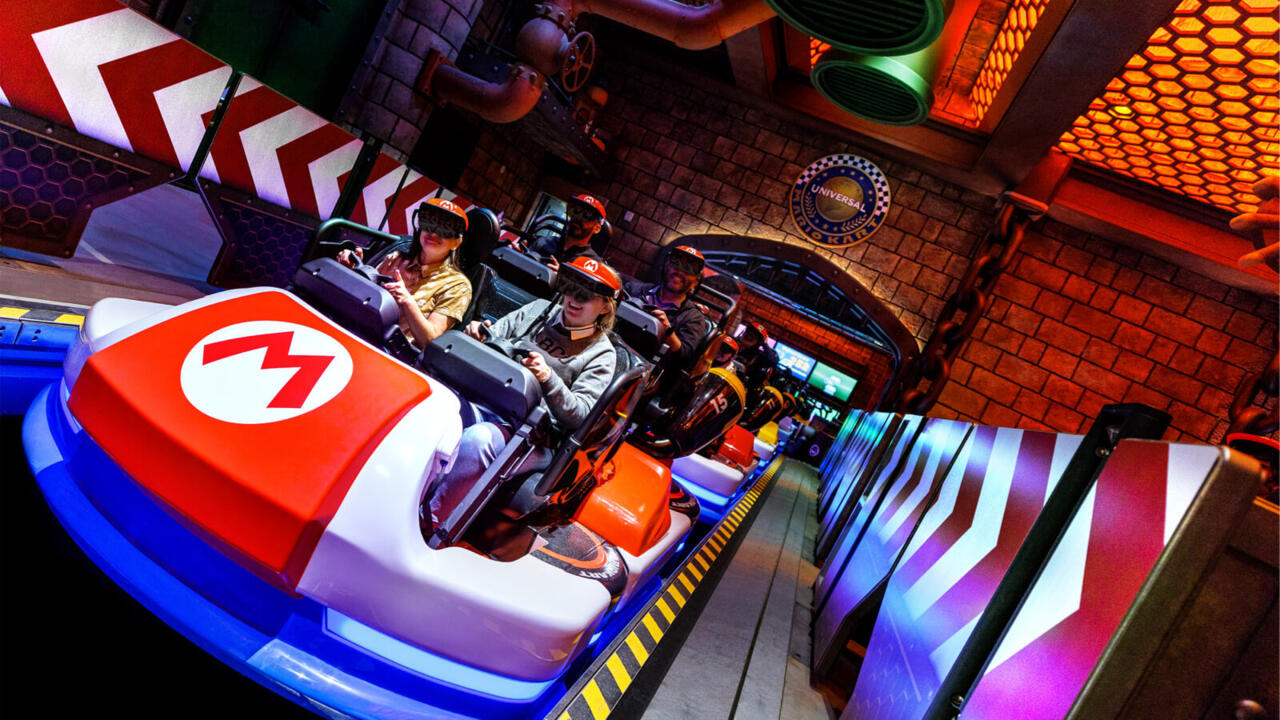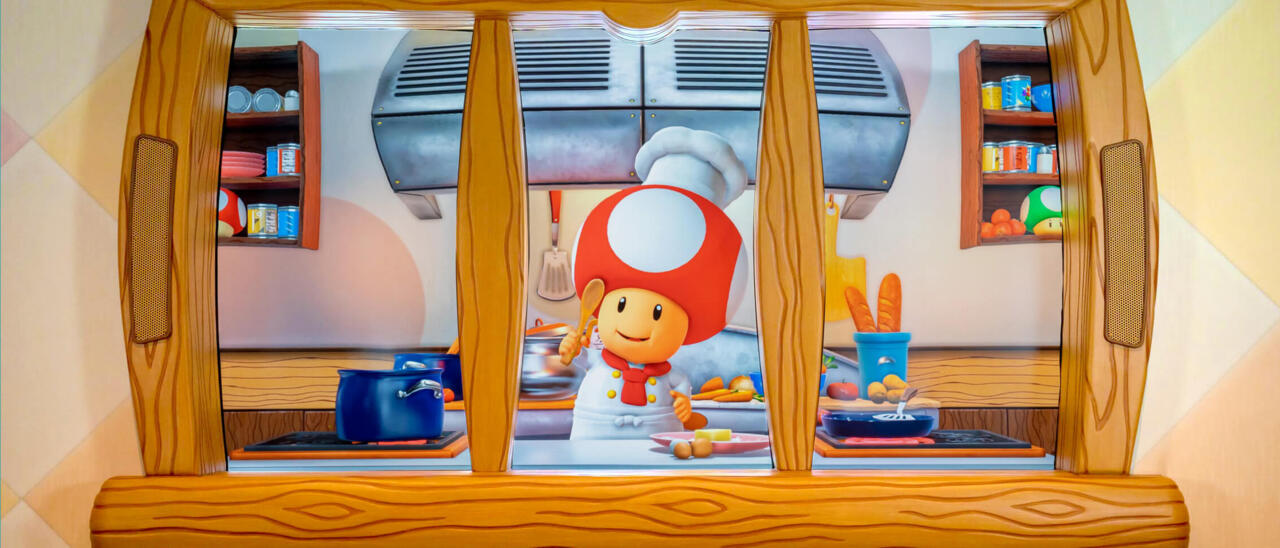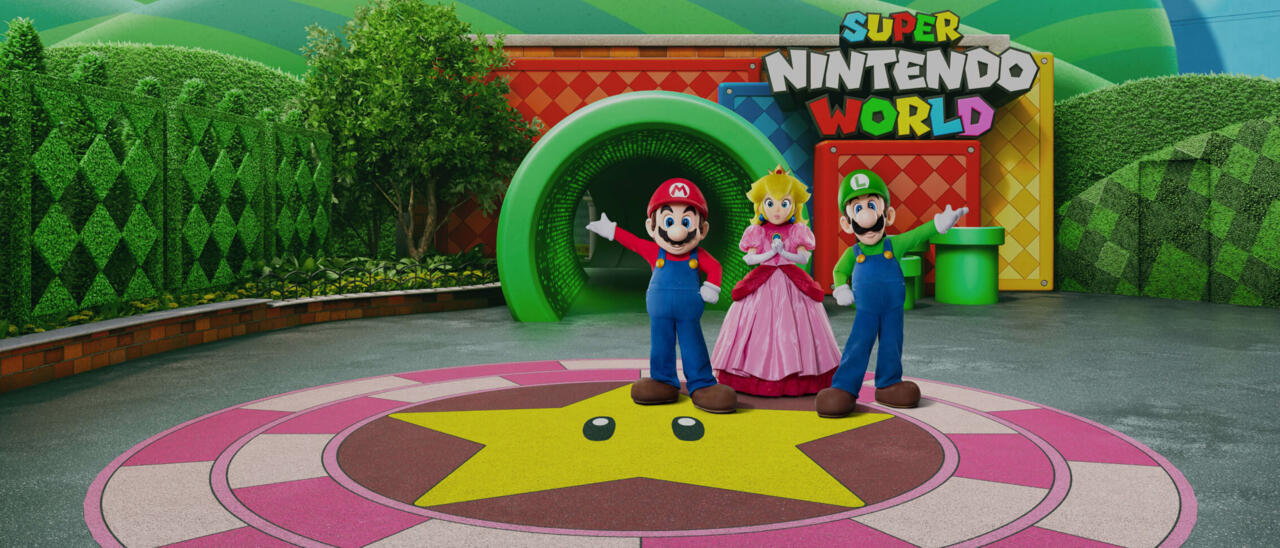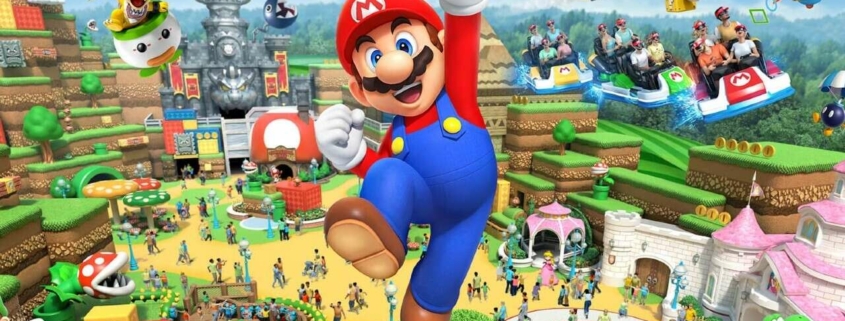What Super Nintendo World Is Like–And How Miyamoto Helped Build It


It’s strange to think that there are still new frontiers of achievement available for a person with a career as illustrious as Shigeru Miyamoto. At this point, he and his Nintendo cohorts have shaped entertainment and pop culture around their barrel-rolling apes and pipe-hopping plumbers in a way that has stood the test of time. Its games have been cultural touchstones for multiple generations of people.
But, somehow, Nintendo and Miyamoto’s successes continue to reach new heights. Walking through Super Nintendo World, an area of the Universal Studios’ Hollywood park that has been modeled to look like the Mushroom Kingdom, is surreal. It feels like the world we’ve hopped, skipped, jumped, and butt-stomped through but captured in a bottle for people to explore. And when you’re standing in a real place that looks like a virtual world you’ve formed such an intense attachment to, it’s difficult not to be caught up in the wonder of it all.
Doubly so when you spot all the little details of the Mushroom Kingdom, lovingly brought to life and carefully placed so that, no matter where your sightline is, there’s something that will delight. Being in Nintendo World activated instincts that I’ve honed through years of playing Mario games as almost involuntary responses. I watched a Koopa Trooper shuffling along a grassy platform and immediately began judging what the best distance to launch onto its head would be. As I scanned the giant green pipes and yellow coin blocks, my eyes were pulled away from the life-sized Mario and Luigi snapping selfies and towards a distant 1UP mushroom, and I thought to myself, how do I get up to that?
But being in Nintendo World is disarming; its sights and sounds activate the part of your brain that pumps out joy and nostalgia. The sensation is a lot like the excitement you probably felt as a child when you saw some random piece of merchandise for a thing you loved–that disbelief that something you were obsessed with on TV or in a movie or book was in the real world, in front of you. It is a little bit magical.
That is only possible because of the care and attention put into creating the world. You’ll hear familiar music being pumped through speakers, creatures you love moving around, and if you purchase a wristband, you can connect to an app and keep track of little quests that can be undertaken while in Nintendo World. The premise is that Bowser Jr. has nabbed a golden mushroom, and to defeat him and get it back, you need to get three keys by completing three challenges. One involves running between clocks in a small area and hitting them when they turn red repeatedly until the timer runs out. If you manage to hit enough, you’ll hear a jingle play and then tap your wristband to collect the key. Another sees you turning a crank as quickly as you can, while the third is a timing-based game centered around hitting a POW block. There are plenty of other little games scattered around and, crucially, they all adhere to the spirit of Nintendo by being simple, fun, and designed to be played with others. Placed around Nintendo World are yellow question blocks which you can punch with your wristband on to pocket the coins within–they take a little bit of force, which makes it satisfying. The app reflects your total amount, and as you explore the park, you’re encouraged to complete smaller tasks to unlock achievement stamps.

The star of the show, of course, is the Mario Kart attraction that mixes a dark ride with AR. You sit in a physical kart and line up on a grid in front of Bowser’s Castle, but quickly go off course when the gate unexpectedly closes. From there, the ride takes you on a tour of some of the most iconic Mario Kart tracks, all deftly mixed together to take you on a thrilling ride as you compete to collect more coins for Team Mario than the opposing Team Bowser can. The ride is on rails, but there are moments of dynamism to keep things exciting; you will spin out of control because you’ve been hit by a shell, or get covered in ink, and you can recover by steering in the direction prompted.
You’ll be able to run through item blocks and get shells, which you shoot by hitting buttons on the steering wheel. Aiming is done by simply looking at your target, since they all appear visually through the AR headset. As you’re going through the twists and turns of the track, various characters from the Mario Kart roster will come in and out of view as you pass each other, and the goal is to nail them with shells to get ahead and score coins. It’s a simple and fun ride that ends with a spectacular mad dash through Rainbow Road.
There’s plenty more to see in Nintendo World beyond this, whether that’s playing more games or just sightseeing using AR binoculars located on the second floor of the world. Despite being a relatively small area, it is so jam-packed with fan service to marvel at that I can see people spending hours here simply hanging out. Nintendo World feels like a contained world, completely separate from the vibe of the rest of the park. You enter through a pipe that plays the going-down-a-pipe-jingle, and walk out into the Mushroom Kingdom. You’re transported from a park filled with tributes to movies that are all connected by ordinary streets and run-of-the-mill walkways to a place that feels like a video game come to life.
Like I said, as a fan of Nintendo it was surreal, so I can only imagine what being there must be like for Miyamoto. His successes designing and developing games are momentous and have brought happiness to people of all ages. They have cemented him as a legend; a creator that towers over the video game world. But now there’s a place where the world he created towers over him, where he can see the joy it brings on the faces of people around him. And, hopefully, he can look at the Mushroom Kingdom with the same awe we’ve always seen it with.
After spending some time at Nintendo World, I had the opportunity to sit down with creator of Mario–Nintendo fellow Shigeru Miyamoto–and general manager of the entertainment planning division Shinya Takahashi to talk about what it was like to bring their video games to life, what they learned about the experience, how they see Nintendo as a company, and more.
You’ve achieved huge success with video games; Mario is beloved and Nintendo is also beloved. But this seems like a very different kind of representation of the success that you’ve achieved. How does it feel to be in this world enveloped by your creation and how does it compare to all the other measures of successes and the measures that you’ve had so far?
Shigeru Miyamoto: Honestly, I had a lot of fun. It was a happy experience. We decided to try to recreate the world [from] the game alongside Universal. And honestly, I wasn’t sure how convincing this whole thing was going to be, but looking at the finished results, I myself as a fan am very happy and excited.
Shinya Takahashi: I think you all of course experienced this for yourselves because you’ve gone into the park. But for us as developers, of course we know this world, we know all of these elements and yet for us, even as we passed through the [warp] pipe ourselves and we’re able to see what was created with our own eyes, we experienced that moment of wow for ourselves. And I think that was fantastic. So again, for us it was the same experience.
After so many years of designing virtual experiences that so many people guide their characters through, how did it feel to design a physical space? Were there aspects that translated from the work you’ve done in what was totally new when you were designing it?
Takahashi: One of the things I think that we were able to experience as we were going through this whole process was thinking of what we’re going to create and how we’re going to create it. There’s a little bit of uncertainty about what’s going to be at the end of this. Is this going to be something that has been worth all this effort, something that’s going to be valuable? But then as Mr. Miyamoto explained earlier, when we were able to actually interact with, say, the question block for the first time and actually hit it and get that feeling of the coin sounds and knowing that we are able to create something that does bring that interactivity to life. That was where we first had that first sense of, “Okay, this is going to work out for us.”
Miyamoto: So in reality, really we end up building a big building as you can see, and I wanted to climb it. But there’s experiences that happen in real life that [don’t] happen in video games. For example, in Mario, when you’re going into, say, a dungeon and you go into the dungeon in the game, it’s just a scene switch. But in real life there is a transition phase that you have to go through. Or say in the game world there’s Yoshi and Koopa Troopas always moving, so we wanted to make sure that they were always moving in real life as well. But then there’s concerns like, “Is it actually going to be convincing? Is it actually going to turn out the way we want it to?” And after seeing all of these elements come through and actually having them all together in one place and seeing them function, I had this moment where the landscape I’m seeing really links up with my game experience that I’ve had in the past. And really it kind of synced up and matched and realizing all of the elements have come together to make this possible is a moment.

It’s called Super Nintendo World, but it has a very Mario theme. It follows a lot of the same characters that exists in the Mario universe. Can you talk about how you landed on that decision of “We want to have a Mario-centered theme”?
Miyamoto: As you said, it is Super Nintendo World, and there was discussion about adding other IP in there like, say, Splatoon. But instead of having our focus scattered, we thought it would be best to start with something focused and make sure something that’s quality and good. And so that’s where we ended up starting with Mario. However, because of that backdrop, if you notice you might be able to find some other IP sprinkled in the world. So I encourage you to take a look.
Obviously you’ve been working with Mario, you created Mario, you’re with the character and that world constantly to the point where it probably becomes quite an ordinary part of your life. But on the other side, people that play the games, this is a world of imagination. They look upon it with awe and they’re dazzled by it. When you enter the world there, has it changed the way you see your work or the world of Mario? Does it reframe how you think about the property, seeing other real humans actually expressing joy as opposed to being separate behind the TV and playing?
Takahashi: I mentioned this earlier when I went into the land itself and I had that experience of being like, “Oh my gosh, it’s here. We created this.” That was definitely part of it, but I think there are two parts to my own reaction because, as someone who works with Mario on the daily and does this regulation and observation of the Mario world, of course there are parts where I was like, “No, no, not quite, maybe make some corrections over here.” So, again, there are two lenses through which I was viewing the world, but when I do look at the Super Mario world, I’m thinking of how Mario will become that connective tissue between generations and families. So we have those small children coming in who don’t know Mario, who haven’t played the games yet. And then as we move up through these kids to their grandparents or their great-grandparents, Mario and Nintendo World, and Mario himself as a character in the franchise can be that connective tissue that runs through those generations. That’s something I think we can look forward to achieving with this theme park.
Miyamoto: For Nintendo, the idea of games is something that brings the family together in the living room and interact and [act], as mentioned, like a connective tissue. And when we’re talking about games, it really just happens in the living room. But as you were saying, when you expand that out to this whole space, this entire space can be used to do just that. And really this concept of while simple was something that was very new to experience for the first time. And I hope that this is something that, as you said, brings everybody together and expands that idea of games to a whole new level.
I wanted to ask how you approach thinking of a space for first-timers as well as people who have loved Mario for years and years, especially as you talk about kids, whether as you’ve seen kids try out the park, they’ve interacted with the park in unexpected ways, and kind of the process of the hidden elements of exploration all around the park?
Miyamoto: When I think of parks, like an actual park in your neighborhood, I think maybe there’s a fountain and you walk around barefoot in it, or there’s like a hill and you just roll down it. That’s what I imagine. And although I would love to have that available here, there’s safety concerns to take into consideration. So while we guarantee safety, we provided ways of interacting with the park like the question block that you can hit to get coins. And while at this point we haven’t seen anything super unexpected in terms of how people interact with the world, I hope that this really provides place for people to really share and interact in a new way for them
Takahashi: I think if we’re looking at creating a space for people to play, especially more than trying to create something for fans, we’re trying to create a place for everyone to play. And for kids it can be pretty easy. You put a block in there, they’re going to go hit it, there’s a coin sound, it’s pretty cool. There are other activities that children will naturally lean into. But the challenge of course is creating a space for the entire family to enjoy together. But I do think we have accomplished that.
Miyamoto: Just to add to what Mr. Takashi was saying, really as long as you make an experience that’s relatable and fun for fans to engage in, then naturally the kids will be able to have fun with that because it’s an engaging experience for the fans and kids. When you go to other parks, you might see the kids playing and then the parents are just kind of resting on the side. And that’s something that you observe there, that you may not observe here.

Can you talk a little bit about the collaboration with Universal, what they taught you about designing a space like this and then what you wanted to bring to a space like this to make it stand out from everything else in Universal or just around the world in terms of parks?
Miyamoto: Universal has a history of really making sure that they value the original intent of the original creator. And that’s something that was clear to us. And then the other point is that this concept of interactivity is something that Nintendo can really collaborate and provide a lot of insight into. And so in that sense, we are the original creator of the IP, but we are also collaborators, and I think this collaboration is something that you probably won’t see anywhere else. I think that’s something that you’ll also be able to experience the difference as you engage with the park.
Takahashi: I think for a few years that Mr. Miyamoto was not super heavily involved in some of our software development, and the reason why is because he was working his butt off trying to get this stuff done. But I do think it really was a true collaboration. There was direction coming from Mr. Miyamoto to the Universal creative team. The Universal creative team were coming back with ideas of their own. And again, in that way I think we did see a really unique collaboration process between the two companies.
Have there been things that you’ve learned here that make you eager to go back to games and translate the knowledge of creating a physical space for people back into gaming?
Miyamoto: For me, there wasn’t any specific learning that would apply to games. In the past, I’ve done things like an interactive program to be used in Kyoto for Japanese card games. And also there was an interactive guide for the Louvre that we had for the 3DS. And so I’ve been involved with a lot of programs and initiatives that involve games in a more interactive way. And then speaking of interaction, this theme park really is a kind of mix of using programming and using things that appear on the screen. So rather than say there was a learning that then gets used into game development, it’s more like our work and the scope of our work is expanding.
Takahashi: Another example of course is the Mario Kart Bowser’s Challenge. This is an experience you can’t have just on a video game console, right? Through the use of AR and other technologies, we are able to leverage our own experiences to create something that moves beyond the experience that you would have in just the game. And really rather than say this is a learning point, it’s just the sheer joy of being able to create something like this in collaboration with Universal was really great.
One of the phrases people use to describe Nintendo and Mr. Miyamoto is “Nintendo is the Disney of the video game world” or “Mr. Miyamoto is the Walt Disney of the video game world.” Now we’re at a stage where that comparison is more apt but you kind of have to drop the “of the video game world” part of it because this park exists and so do movies and [Mario] is everywhere now. How do you both feel about that comparison and how do you think of yourselves as a company now that you’ve moved into a place where you have a Hollywood movie, you have an actual theme park attraction?
Miyamoto: As you said, I’ve also been called the Spielberg of the game world, but I actually don’t like that. I’m Miyamoto. Miyamoto is Miyamoto and Nintendo is Nintendo. However, I do feel very honored to be compared with Disney. But with that said, rather than comparing Nintendo to Disney, I feel that Disney to some extent, especially for families, [represents] a sense of reassurance for families.
I feel like Nintendo is well known for video games and usually video games don’t equate to reassurance very much. But Nintendo is associated with video games and the fact that Nintendo is then being compared to Disney really gives me the [confidence] that we’ve gotten to a point where we can bring Nintendo to the concept of reassurance and perhaps [give that] reassurance. So that’s something that I really feel like we were able to achieve and I’m happy about. And beyond that, I think it’s really up to Mr. Takashi and how he carries everything forward. And so why don’t you ask him.
Takahashi: We as developers think of ourselves more as an entertainment company. That’s where our goal is. And so we look at not only games, we moved into the game of the park, we also have a movie which will soon be coming out and we hope you all enjoy it. We are trying to, as much as possible, move closer to that ideal that Mr. Miyamoto referenced where we’re a company that’s associated with reassurance for the family members. And we also want to continue to challenge things and take on different challenges, and really get to a point where both the people creating the entertainment and the people engaging in being entertained by the entertainment can enjoy [it]–that’s what we want to aim for and shoot for. Nintendo is Nintendo, and we’re different than everyone else.
Nintendo has developed this incredible reputation for creating these experiences that families can have together, but also really being on the cutting edge of technology and the idea that the two can come together to create something new and something memorable. And so I’m curious if both of you have a particular new kind of creative experience or technology that you have your eyes set on what the future might look like or any other places we might see Mario and his friends pop up in.
Takahashi: I really don’t consider us a cutting-edge company. That’s something for tech people, for programmers and whatnot to aspire to. We as a company want to take technology available to us and implement it in games in a way that is easy to use and easy to understand.
Miyamoto: As a company, I think we’re always looking for unique uses of technology. We know a lot of different types of technology, but it’s really in how we use that in a unique way and then distill that into a product is what I feel Nintendo is adept at. When Mario was created, it became popular and we thought that Mario became popular because it was a fun game. And so we thought that for every introduction of new technology, new ways of doing things, Mario can then evolve alongside that. So for every kind of hardware we’ve had a new Mario, and it’s the same thing within the park. We have AR technology and Mario Kart that’s blended together to create this harmony of the actual physical backdrops that are in the physical space and the changing virtual backdrop that’s in front of the screen. And I think that’s something that has really made this experience a great one. For any future technology that comes, we will assess whether that’s best suited for Mario and continue to evolve.
The products discussed here were independently chosen by our editors. GameSpot may get a share of the revenue if you buy anything featured on our site.
Source link




